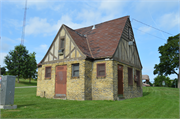Property Record
2230 N Bremen St
Architecture and History Inventory
| Historic Name: | Kilbourn Park - Comfort Station |
|---|---|
| Other Name: | |
| Contributing: | |
| Reference Number: | 240474 |
| Location (Address): | 2230 N Bremen St |
|---|---|
| County: | Milwaukee |
| City: | Milwaukee |
| Township/Village: | |
| Unincorporated Community: | |
| Town: | |
| Range: | |
| Direction: | |
| Section: | |
| Quarter Section: | |
| Quarter/Quarter Section: |
| Year Built: | 1920 |
|---|---|
| Additions: | |
| Survey Date: | 2019 |
| Historic Use: | park shelter/building |
| Architectural Style: | English Revival Styles |
| Structural System: | |
| Wall Material: | Brick |
| Architect: | |
| Other Buildings On Site: | Y |
| Demolished?: | No |
| Demolished Date: |
| National/State Register Listing Name: | Not listed |
|---|---|
| National Register Listing Date: | |
| State Register Listing Date: |
| Additional Information: | 2019: Kilbourn Park (AHI No. 16354) was created in 1872-73, when the Kilbourn Reservoir was constructed. The reservoir was a seven-sided structure embedded in the hillside, that could hold up to 21 million gallons of water when full and was intended to store and distribute drinking water and provide fire protection. The park-like setting and hill created by the reservoir was a popular destination for Milwaukee’s residents, who enjoyed the park’s walkways and summer concerts. The reservoir structure was no longer in use by 2004, and the reservoir structure was removed in 2006 and 2007. The surrounding park was redesigned at that time, with the reservoir space filled with earth to maintain the characteristic hill. The comfort station in the northern end of Kilbourn Park is a small, one story Tudor Revival building constructed in 1931. The building is constructed of cream brick with half timbering in the eaves of the steeply-pitched gabled roof. A gabled projecting bay is located in the center of the southeast elevation, and contains a metal doorway and two small flanking double-hung windows. Windows throughout appear to be original, and are topped by a soldier brick lintel. Several of the windows are covered with metal grating to protect the glass behind. |
|---|---|
| Bibliographic References: |
| Wisconsin Architecture and History Inventory, State Historic Preservation Office, Wisconsin Historical Society, Madison, Wisconsin |

